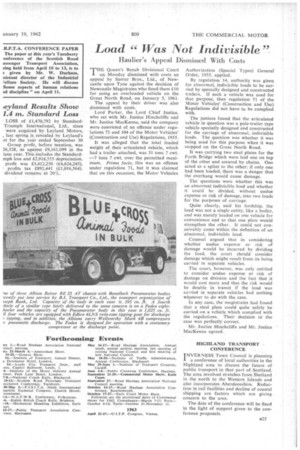Load " Was Not Indivisible"
Page 31

If you've noticed an error in this article please click here to report it so we can fix it.
Haulier's Appeal Dismissed With Costs
THE Queen's Bench Divisional Court on Monday dismissed with costs an appeal by Sunter Bros., Ltd., of Newcastle upon Tyne against the decision of Newcastle Magistrates who fined them £10 for using an overloaded vehicle on the Great North Road, on January 5, 1961.
The appeal by their driver was also dismissed with costs.
Lord Parker, the Lord Chief Justice, who sat with Mr. Justice Hinchcliffe and Mr. Justice MacKenna, said the company were convicted of an offence under regulations 71 and 104 of the Motor Vehicles' (Construction and Use) Regulations, 1955.
It was alleged that the total loaded weight of their articulated vehicle, which had a trailer attached, was 31 tons 7 cwt. —7 tons 7 cwt. over the permitted maximum. Prima facie, this was an offence under regulation 71, but it was claimed that on this occasion, the Motor Vehicles Authorization (Special Types) General Order, 1955, applied.
By regulation 14, authority was given for abnormal, indivisible loads to be carried by specially designed and constructed trailers. If such a vehicle was used for that purpose, then regulation 71 of the Motor Vehicles' (Construction and Use) Regulations did not have to be complied with.
The justices found that the articulated vehicle in question was a pole-trailer type vehicle specially designed and constructed for the carriage of abnormal, indivisible loads. The question was whether it was being used for this purpose when it was stopped on the Great North Road.
It was carrying two steel plates for the Forth Bridge which were laid one on top of the other and secured by chains. One acted as a splint to the other: if only one had been loaded, there was a danger that the overhang would cause damage.
The questions were whether this was 'an abnormal indivisible load and whether it could be divided, without undue expense or risk of damage, into two loads for the purposes of carriage.
Quite clearly, said his lordship, the load was not a single entity, like a boiler, and was merely loaded on one vehicle for convenience and so that one plate would strengthen the other. It could not conceivably come within the definition of an abnormal, indivisible load.
Counsel argued that in considering whether undue expense or risk of damage would be incurred by dividing the load, the court should consider damage which might result from its being carried in separate vehicles.
The court, however, was only entitled to consider undue expense or risk of damage on division and the fact that it would cost more and that the risk would be double in transit if the load was carried in separate vehicles had nothing whatever to do with the case.
In any case, the magistrates had found that a steel plate could quite safely be carried on a vehicle which complied with the regulations. Their decision in the case was perfectly correct.
Mr. Justice Hincheliffe and Mr. Justice MacKenna agreed.
HIGHLAND TRANSPORT CONFERENCE
INVERNESS Town Council is planning I a conference of local authorities in the Highland area to discuss the future of public transport in that part of Scotland. The area involved stretches from Shetland in the north to the Western Islands and also incorporates Aberdeenshire, Reduction in rail facilities and decline of coastal shipping are factors which are giving concern to the area.
The date of the conference will be fixed in the light of support given to the conference proposals.












































































































